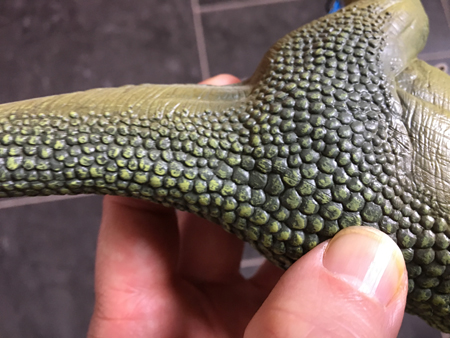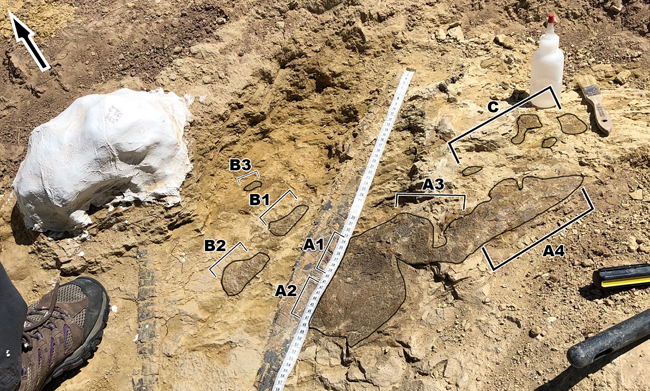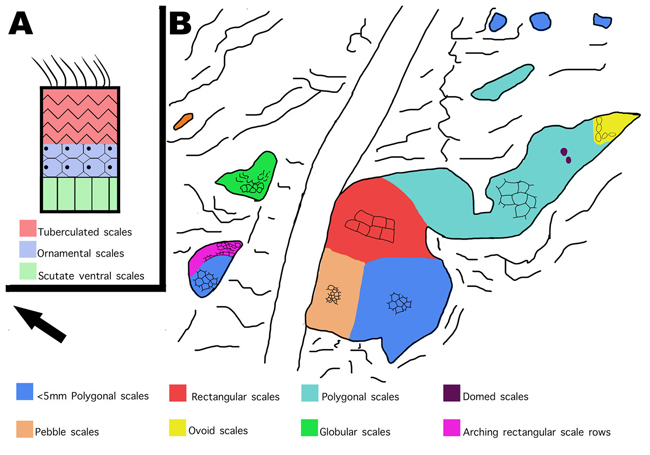The Amazing Skin of Diplodocus
The debate over whether theropod dinosaurs were feathered, scaly or perhaps a combination of both continues. In contrast, the integumentary covering of sauropod dinosaurs has largely remained uncertain due to the very limited fossil evidence. However, at one remarkable location in Montana, patches of fossilised Diplodocus skin have been preserved and an analysis indicates that these long-necked dinosaurs were most likely covered in scales, but surprisingly their skin scales were not uniform. A range of scale shapes are indicated, all of them relatively small, but ovoid, rectangular, polygonal, domed scales and irregular (globular) scales have been identified.

A Research Paper
In a scientific paper published in the on-line, open-access journal PeerJ (April 2021), written by Tess Gallagher (currently a Masters student at Bristol University), in collaboration with colleagues from, what was known at the time as the Bighorn Basin Paleontological Institute, descriptions were provided of some patches of skin associated with juvenile Diplodocus fossils.
The fossil material comes from a single location known as the Mother’s Day Quarry, located in the Bighorn Basin, (Montana). The site was originally discovered in the 1990s and the Upper Jurassic deposits have yielded over two thousand Diplodocus fossil bones. Surprisingly, given the concentration of sauropod material found, very few other fossils have been discovered in this quarry. To date, some theropod teeth (allosaurid) are known plus one potential theropod footprint, preserved in association with the skin and a single invertebrate specimen.
It has been suggested that a herd of young Diplodocus dinosaurs died from lack of water at a dried up watering hole. Their bodies remained on the surface for some time and became desiccated. A flash flood occurred and swept the corpses downstream and these accumulated bodies were rapidly buried.
The dinosaur skin, having been bleached and dried out on the surface, once rapidly buried has an increased chance of becoming fossilised. Recently published research (October 2022), from Drumheller et al suggests that “mummified” skin might be more common in the fossil record than previously thought.
To read Everything Dinosaur’s blog post about this phenomenon: Dinosaur Mummies an Alternative Fossil Pathway.
Fossilised Diplodocus Skin
Although only a small portion of skin has been identified to date and the scientists remain uncertain as to which part of the body the skin patches covered, analysis has revealed a remarkably diverse quantity of scales. The team conclude that considering how diverse the scale shapes are in such a small area of skin, it is possible that these distinct scale shapes may represent a transition on the body from one region to another, perhaps from the abdomen to the dorsal side, or abdomen to the shoulder.

At least six different types of Diplodocus scale have been identified, suggesting that the skin of these sauropod dinosaurs was complex. In addition, a further study presented at the recent annual meeting of the Society of Vertebrate Paleontology in Canada, provided a fresh perspective on the specialised skin of these sauropods.
Analysis of the scales using a high-powered microscope revealed that they had unusually large pores. It has been proposed that these large pores helped increase the surface area of this huge dinosaur. The greater the surface area of the skin the more assistance it would have been in helping to keep Diplodocus cool. Elephants have wrinkled skin, this increases the skin’s surface area which helps to minimise the impact of the “square-cube law” in relation to overheating.
“Square-cube” Law
The larger the volume of an animal, the smaller the overall surface area of the skin in contact with the air and this makes dissipating heat difficult for large animals. Just as elephants help to resolve issues with overheating with their wrinkled skin, the large pores associated with the Diplodocus skin had a similar effect.

The scientific paper: “Evidence of integumentary scale diversity in the late Jurassic Sauropod Diplodocus sp. from the Mother’s Day Quarry, Montana” by Tess Gallagher, Jason Poole and Jason P. Schein published in PeerJ.

